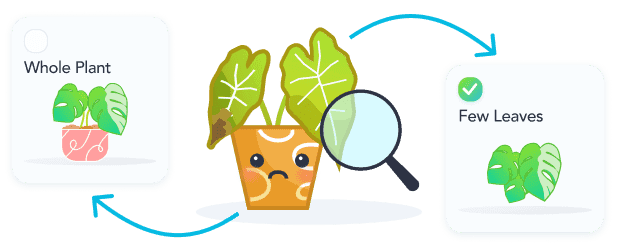Every 7d
Recommended Frequency
1 /2 cup of water
Recommended Amount
Water your Mini Monstera deeply once a week, allowing excess water to drain from the pot. Allow the soil to dry slightly between waterings.
Every 14d
Recommended Frequency
Fertilizer your Mini Monstera every two weeks during spring and summer using a diluted liquid fertilizer.
Indirect Sun
Recommended
Indirect Sun or Filtered Sun is when sun exposure is being filtered through a sheer curtain or is not able to have the sun's rays directly hit the leaves/flowers of your plant.
Every 365d
Recommended Frequency
Repot your Mini Monstera once a year, or once it outgrows its pot.
For mini monstera plants, maintaining a temperature range between 75 to 85 degrees Fahrenheit is ideal. This range supports their growth and health, aligning with moderate to high temperature preferences. Summary: Mini...
Peat Soil
Recommended Soil
Peat Soil is an acidic soil that retains a lot of moisture and slows decomposition. Due to such a high moisture retention this mix may require irrigation to help with draining. This soil type is best used when paired wit...

Shop Mini Monstera
Questions about Mini Monstera
A mini monstera, scientifically known as Rhaphidophora tetrasperma, is a tropical plant native to Southeast Asia. Despite its common name, it is not a true Monstera but shares similar split leaves. It's a fast-growing, c...

Toxicity of Mini Monstera

Common Pests and Diseases
Leaf Curling and Drooping
Underwatering
To address leaf curling and drooping caused by underwatering, it's crucial to establish a consistent watering schedule that keeps the soil slightly moist but not waterlogged. Check the soil moisture by inserting your finger about an inch deep; if it feels dry, it's time to water. Use lukewarm water to avoid shocking the plant's roots. Additionally, consider increasing humidity around the plant through misting or using a pebble tray with water. Monitor the plant's response and adjust the watering frequency as needed, especially during warmer months when the soil tends to dry out faster.
Spider Mite Infestation
Spider mites are tiny pests that thrive in warm, dry conditions. They feed on the sap of the mini monstera, causing yellowing, speckled leaves, and webbing on the plant.
To combat spider mites, first isolate the affected plant to prevent spread. Increase humidity around the plant as spider mites prefer dry conditions. Wash the plant gently with water to remove mites and webs. For severe infestations, use a neem oil solution or insecticidal soap, applying it thoroughly to the leaves, especially the undersides, every 7 days for at least 3 weeks. Regularly check the plant and its surroundings to ensure all mites are eradicated.
Leaf Yellowing
Nutrient Deficiency
Leaf yellowing in mini monstera, not caused by watering or pests, often points to a nutrient deficiency, particularly nitrogen. To address this, ensure the plant is fertilized regularly with a balanced, water-soluble fertilizer, following the recommended dosage on the product label. It's crucial to not over-fertilize, as this can lead to further issues. Incorporating a slow-release fertilizer can also help maintain consistent nutrient levels in the soil.

Related Plants
Other Articles:
Top 10 Most Popular Roses
Mar 22, 2022
How to Care for China Roses
Mar 11, 2022
How to Care for Chinese Money Plants
May 15, 2020
How to Grow and Care for A Bird of Paradise
Apr 26, 2020
Top 10 Plants To Grow In A Terrarium
May 31, 2022
How to Grow and Care for Lucky Bamboo
Mar 29, 2022
How to Grow and Care for Corn Plants
Mar 29, 2022
How to Care for Madagascar Dragon Trees
Mar 21, 2022



